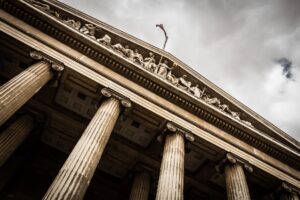Accidents and Hearsay Statements

If you’re a fan of courtroom television, then you have likely watched countless scenes of lawyers saying, “Objection. Hearsay!”
However, very few people know what the actual hearsay rule means and how it affects personal injury cases.
The following article contains some legal information to give a general understanding of the rules of hearsay and how it can impact your potential personal injury claim. If you have any questions or concerns about hearsay, we strongly encourage you to reach out to a personal injury lawyer to discuss your options.
What is Hearsay?
Often referred to as indirect evidence, hearsay is any written or spoken statement that was made outside of court by someone other than the person who suffered or witnessed the loss or injury. Hearsay statements are used in court to prove the truth of the matter asserted. In other words, hearsay evidence is introduced at trial when a witness testifies about something that he or she heard about but didn’t witness personally to prove that the contents of the hearsay statement are true.
For example, say the person injured in a car accident (the Plaintiff) testifies in court that a witness to the car accident said the at-fault driver (the Defendant) ran a stop sign. In this case, the plaintiff’s testimony is considered hearsay because they did not personally see the defendant run a stop sign and they are using a statement made by a witness who is not in court.
Example of Hearsay in a Car Accident
Suppose a witness to a car accident says, “I saw the red Chevrolet make a left turn and hit the green Ford in the front passenger side.” This is not considered hearsay because the witness is describing what he or she saw happen. Alternatively, if a witness says, “I heard a crash and looked over to see an accident had occurred. Steve was standing there and told me that he saw the red Chevrolet collide with the green Ford while making a left turn.” This is considered hearsay because the witness did not see the accident, they are only reporting what Steve said.
Is Hearsay Evidence Admissible in Court?
The Hearsay Rule is a legal principle that generally prevents statements made outside of court by someone other than the person who suffered or witnessed the loss or injury from being admissible as evidence in Canadian courts. The purpose of this rule is to prevent people from using statements made by others to prove a fact in court unless the person who allegedly made the statement can be brought to court to testify.
The theory behind the hearsay rule is that many statements made by people are often unreliable. Statements are prone to errors due to a person’s memory or perception, or they may be inaccurate when recounting an event. For this reason, the concerns with hearsay statements surround the inability to question (cross-examine) the person that made the statement because they are not present in court. If someone is making statements that can damage your case, you want to be able to cross-examine them to test the reliability of those statements and the trustworthiness of the person making them.
Are There Exceptions to the Hearsay Rule?
As with any rule, there are exceptions, and the hearsay rule has plenty of them. The two most common exceptions to the hearsay rule are traditional exceptions and the principled approach.
Traditional Exceptions
In traditional exceptions, hearsay statements that can be reliably verified or that can be adequately tested are admitted into evidence in order to facilitate the search for truth.
Business Records: This exception allows for a written record of a statement that is kept in connection with a business to be admitted into evidence. For example, maintenance logs are often used in slip-and-fall claims to prove that the property owner knew or ought to have known about the dangerous conditions, and it was unreasonable for them not to fix it in time. To be considered an exception to the hearsay rule, the business records must satisfy the following conditions:
- The record must be made at or near the time of the incident
- The record must be made in the regular course of business operations
- The record must be made by a person with knowledge of the incident who can testify to their identity and mode of preparing the record
Admissions Against Interest: If a party to a lawsuit says something that hurts their case, that statement can generally be admitted in court as evidence. In the case of Jones v. Ma, the plaintiff approached the defendant after a car accident and asked to record the conversation. The defendant consented and admitted fault for causing the accident. The fact that the defendant did not know at the time of the conversation that what they said might be used in court is not a basis for excluding the recording as evidence.
Spontaneous Utterances: These statements are made while the witness is under stress or excitement caused by an event. In a car crash, a witness could blurt out that they saw a car run a red light and hit a pedestrian. This type of statement could be an exception to the hearsay rule because it was made at the moment the car accident happened and there is a certain level of emotional intensity that is met.
Past Recollection Recorded: This exception allows for someone to testify about their past recollection of a statement that was recorded at the time of the incident. This is often used in cases involving auto accidents. The expert witness may be able to testify about the condition of the vehicle at the time of the accident based on their examination of the vehicle and the condition of the road at the time of the accident.
Principled Approach
If hearsay does not fall under a traditional exception, it may be admitted into evidence on a case-by-case basis according to the principles of necessity and reliability.
Necessity: The court can establish necessity when there is no other way for the evidence to be presented at trial. For example, the original witness who made the statement has passed away.
Reliability: If the court determines that a statement is reliable based on the circumstances that existed at the time the statement was made, reliability can be established. For example, a statement made by a witness to the police after a car accident.
Let’s presume that there is supporting evidence that the other driver is at fault. Maybe an expert recreates the collision using the same circumstances or maintenance logs show that your vehicle is the only one with proper working breaks.
In addition to the supporting evidence, there would likely be circumstantial or evidentiary guarantees in place that make the statement inherently trustworthy. Suppose there was a witness to the accident. This statement would likely be accepted as true because the witness has no motive to lie (assuming they have no relation to the parties involved), and the statement was spontaneous (given at the time of the accident). Considering all of these factors, the statement is admissible under the principled approach because it both indicates that it is reliable and reasonably necessary.
Keep in mind that the hearsay rule is just one rule of evidence among many. Hearsay evidence can be allowed under one rule but excluded under another. For instance, if an out-of-court statement fits into a hearsay exception but is not relevant to the case, then it will not be accepted as evidence. The question of whether a statement is hearsay is only one step in determining its admissibility in court.
Personal Injury Cases, Negligence, and Hearsay
There can be a significant impact of the hearsay rule on the two main elements in any personal injury case: negligence on the part of the defendant in causing the collision, and the injuries and damages sustained by the plaintiff.
First, to hold someone accountable for causing an injury, the burden of proof falls on the plaintiff (the injured person) to show that the defendant’s (the person who caused the injuries) negligent actions contributed to the accident and resulting injuries. To establish negligence, the plaintiff may introduce out-of-court statements made by the defendant, just like in the case Jones v. Ma discussed above. Conversely, this exception to the hearsay rule applies in reverse. Say the plaintiff told the defendant, “I should have been able to stop in time but I was distracted”. The defendant could use this statement as evidence to argue that the plaintiff contributed to causing the accident and their injuries.
Second, the hearsay rule can impact the amount of damages (compensation) a plaintiff can recover for their injuries. For instance, let’s say the plaintiff’s doctor wrote in their medical file that the plaintiff suffered a lumbar spine injury in the car crash. While medical records are hearsay, they are typically admissible under the hearsay exception for business records. If the medical records indicate that the plaintiff already suffered from lumbar disk disease, the defendant may argue that the plaintiff’s injuries were not caused by the car accident. Depending on the court ruling, the compensation available to the plaintiff may be reduced or denied based on the medical reports introduced as evidence.
Dealing With Hearsay After an Accident
The immediate aftermath of any accident is chaotic at best. Even in a minor fender-bender, the scene is usually crowded with people trying to figure out what happened. Even if you don’t make a statement directly to any single person, being overheard could undermine your claim. The most common people that can overhear information at the scene of an accident include the drivers, passengers, eyewitnesses, police officers, and emergency medical personnel.
Once you leave an accident scene, you will find yourself in situations where you will have to describe what occurred. It’s important to be mindful of any statements that can substantiate the root cause of your injuries.
Following an accident, you will likely talk to:
- Medical Personnel – Use caution when discussing the general cause of your injury (the car accident) with any medical professional, including your primary care physician.
- Insurance Adjusters – After reporting an accident, an insurance adjuster will be assigned to investigate your case and determine who is at fault for the incident. Their goal is to reduce the amount of money an insurer will pay out. Never take responsibility or minimize your injuries. Even saying that you “feel okay” could be used against you to decrease your settlement offer.
- Social Media – While you don’t “talk” to social media, insurance companies can use your posts to weaken your claim. The insurer may look at the date you published a photo during a timeframe you are supposedly suffering a serious injury and conclude that you are lying about the damages in your claim.
These are a few situations in which you could jeopardize your personal injury lawsuit settlement if someone admits a statement as hearsay evidence.
Protecting Yourself From Hearsay Evidence in Court
There are ways to protect yourself from hearsay evidence in court. The first step is to retain legal counsel. An experienced Halifax personal injury lawyer will know how to deal with hearsay evidence and how to construct a solid claim on your behalf. In many cases, a lawyer can advise you on how to avoid making statements that could be used against you in court.
Some ways to prevent damaging your claim include:
- Don’t Give Details – When reporting an accident to your insurance company, discussing injuries with a medical team, or notifying your employer that you will be off work, focus only on the facts of the accident and avoid statements that can be interpreted as admitting fault.
- Avoid Written or Recorded Statements – If an insurance company asks for a written or recorded statement—run. A simple misstatement or answer taken out of context can be used to undermine a legitimate claim, and you are left covering the costs for your injuries.
- Set Limits on Conversations – Until you have the opportunity to investigate the accident and determine the extent of your injuries and other losses (the “damages”), you will not have accurate information to give an insurance adjuster. You can advise them to get copies of the accident report or to speak with your car accident lawyer (sometimes referred to as an insurance claim lawyer) if they continue to ask questions.
Despite being only one sentence long, the hearsay rule can be quite complex, and has several other exceptions not listed in this article. Hiring a Halifax personal injury lawyer who understands the hearsay rule and other rules of evidence can ensure you receive the settlement you’re entitled to.






















